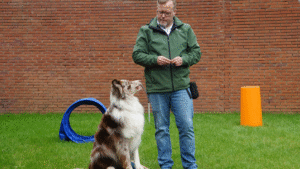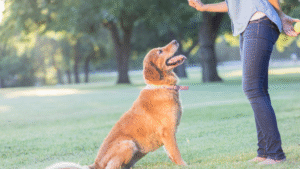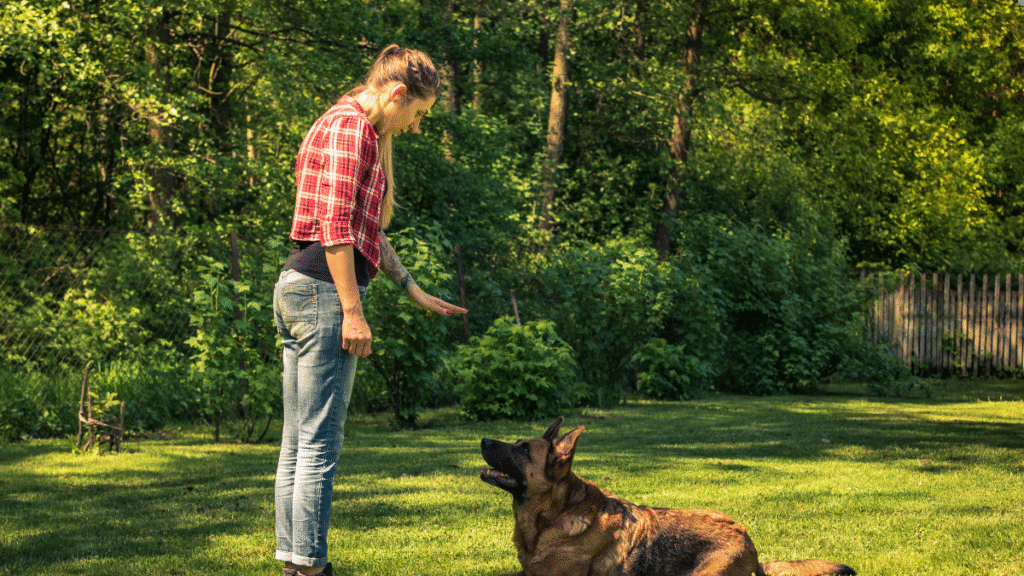The “down” command is one of the most useful and important lessons in basic dog training. It helps your dog relax, develop impulse control and patience, and settle on command in a variety of situations.
Unfortunately, many owners struggle to teach this skill because they approach it with frustration, impatience, or even raised voices.
The truth is, yelling, getting angry, or correcting your dog doesn’t make them learn faster—it actually slows down the process. The fastest and most effective way to teach a dog new skills is by staying calm, consistent, and positive.

Why the “Down” Command Is Important
The benefits of teaching your dog to lie down on command go beyond obedience or safety. When you teach this skill properly, you’re also helping your dog build emotional intelligence and self-control. Specifically, here’s what teaching “down” can do for your dog:
-
Instill calmness: The “down” position is naturally restful. Teaching your dog to lie down on cue helps them settle and relax more easily.
-
Improve impulse control: A dog who can lie down on command instead of jumping, barking, or pacing when overstimulated has learned valuable self-control.
-
Enhance safety: A reliable “down” command can stop your dog from running into dangerous situations or chasing other animals.
-
Develop trust and communication: When you teach “down” calmly and positively, your dog learns to see you as a kind, trustworthy leader.
Why Yelling and Forcefulness Don’t Work
You might think yelling or scolding your dog is effective because it releases your frustration. But in reality, those methods don’t just make you feel better—they make your dog feel worse.
Dogs don’t process tone and emotion the same way humans do. A raised voice or harsh command can scare or confuse them. Being physically forceful can make your dog anxious or fearful, reducing their motivation to cooperate.
A loud or angry tone can lead to several problems:
-
Fearfulness or shutting down, which blocks learning
-
Associating training with stress instead of fun
-
Avoidance or defiance rather than focus and understanding
-
Decreased motivation to follow commands in the future
Training should be about positive reinforcement, not punishment or fear. When you teach commands in a calm and consistent way, your dog can think clearly, focus on your cues, and trust your guidance.

Preparing for Training: Setting the Stage for Success
The first step to teaching your dog “down” without yelling is to create the right training environment. The space and atmosphere you train in are just as important as the methods you use.
-
Choose a quiet, low-distraction environment. Minimize distractions like other pets, children, or loud appliances.
-
Keep training sessions short and focused. Aim for 5–10 minutes at a time, especially with young or easily distracted dogs.
-
Use small, high-value treats. Choose something your dog loves but doesn’t get often.
-
Be consistent with commands. If you choose “Down,” don’t switch to “Lie down.” Consistency builds clarity.
-
Stay calm. Dogs are highly sensitive to your tone and body language. If you’re relaxed, your dog will be too.
Teaching “Down” Without Yelling: Step by Step
Ready to teach your dog “down” the calm way? Follow these steps:
Step 1: Start in a “Sit” Position
Begin with your dog in the “sit” position. Hold a treat in your hand and let your dog sniff it, but don’t allow them to take it yet.
Step 2: Lure Your Dog into the “Down”
Slowly move your hand with the treat from your dog’s nose straight down toward the floor, then out along the ground between their front paws. This motion encourages your dog to lower their body.
As soon as your dog’s elbows and chest touch the floor, say “Yes!” (or use a clicker if you have one) and immediately reward them.
If your dog pops back up or doesn’t get it right away, don’t get frustrated. Take a short break, then try again. Repetition and consistency are key.
Step 3: Add the Verbal Command
Once your dog reliably follows the lure into the “down” position, start adding the verbal cue “Down” as you move your hand.
It may take several training sessions before your dog connects the word with the action. Keep your voice calm and even—never sharp or impatient.
Step 4: Fade the Lure
As your dog improves, begin phasing out the treat lure. Use only the hand signal and verbal cue, rewarding your dog after they complete the behavior.
Eventually, your dog should respond to the command without needing a treat to guide them.
Step 5: Add Duration and Distance
When your dog reliably follows the “down” command, start working on how long they stay down and how far you can move away while they hold the position.
Use a calm “Stay” or “Wait” command, take a step back, and reward your dog for maintaining the position. Gradually increase time and distance as your dog becomes more confident.

Troubleshooting and Common Mistakes to Avoid
Even with good intentions, dog owners sometimes make mistakes that can slow progress or confuse their dogs. Here’s what to avoid:
-
Using an angry or impatient voice: This can make your dog anxious or lose confidence.
-
Pushing or forcing your dog down: Physical pressure can frighten or intimidate your dog. Let them move into position voluntarily.
-
Repeating the command excessively: Saying “Down, down, down” only teaches your dog to ignore the first cue. Say it once and wait.
-
Removing rewards too soon: Don’t stop rewarding too early—consistent reinforcement is essential.
-
Training when your dog is overly excited: If your dog is too stimulated to focus, go for a short walk before training.
Practice and Reinforcement
If you follow this guide, your dog should begin understanding the “down” command fairly quickly. Timing is critical—reward your dog within one or two seconds of the correct response so they clearly connect the behavior with the reward.
Practice frequently, but keep sessions short. Incorporate the “down” command several times throughout the day in different settings to help your dog generalize the behavior.
Use positive praise and a happy, encouraging tone. In addition to treats, your cheerful voice and affection can be powerful rewards.
Applying “Down” in Real Life
The “down” command is incredibly useful in everyday life. Here are some situations where it comes in handy:
-
Before meals or treats (“Down” before placing the bowl on the floor)
-
Before putting on the leash or harness
-
When your dog is overexcited and needs to calm down
-
In public places such as dog parks, patios, or sidewalks
Practicing “down” in different environments will help your dog generalize the command and respond reliably anywhere.

Conclusion
Training isn’t just about obedience—it’s about strengthening the bond between you and your dog. Dogs are intelligent, emotional animals who thrive on stability, trust, and understanding from their humans.
When you teach your dog using calm, positive, and patient methods, you nurture that trust and build lasting confidence. A well-trained dog isn’t just obedient—they’re secure, happy, and connected to you.
By practicing the no-yelling way, you’ll not only teach effective commands like “down” but also create a peaceful, trusting partnership that lasts a lifetime.
- 5 Cheap Alternatives To Dog Training Equipment - November 12, 2025
- Homemade Calming Spray To Help Dogs During Training - November 12, 2025
- 7 DIY Dog Training Tools You Can Make From Household Items - November 12, 2025
